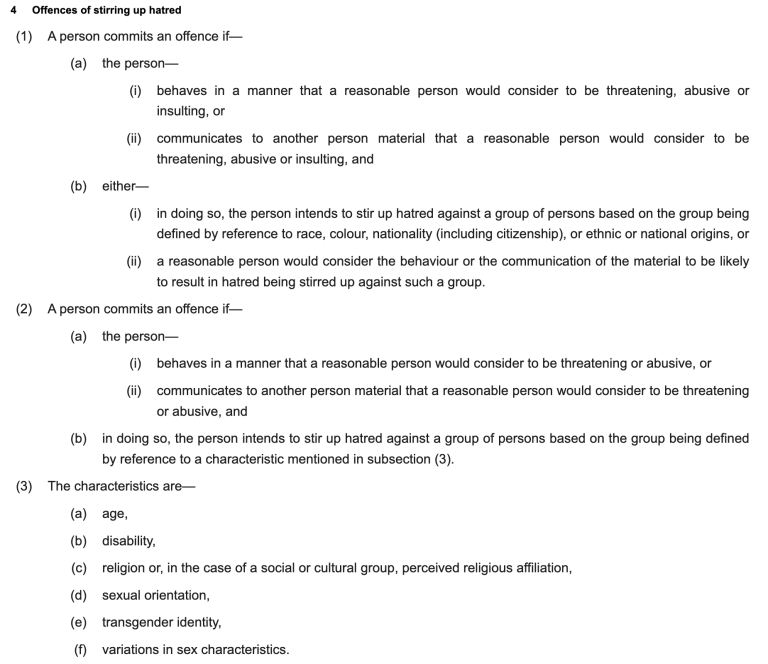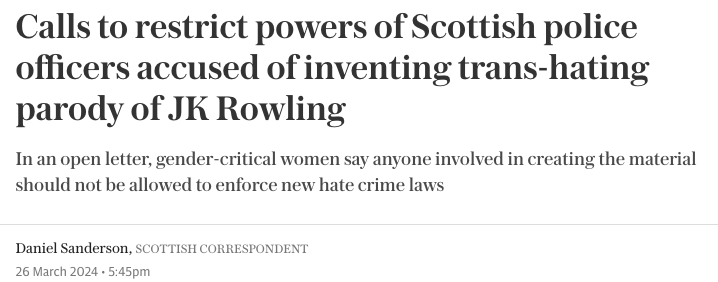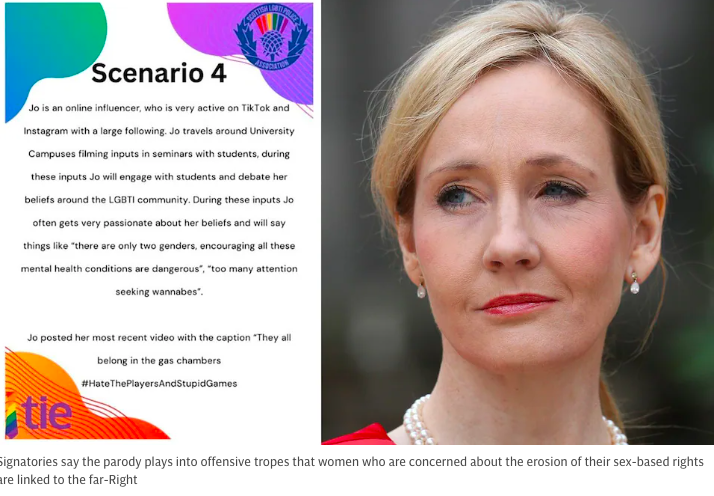There’s a good article in Quillette showing how one person, the notorious but (to me) highly admirable J. K. Rowling singlehandedly undercut Scotland’s new Hate Crime and Public Order Act that came into effect on April 1. I explained this law on March 27, also showing how the Scottish Police published as an example a woman named “Jo” (Rowling’s nickname) who said that people who didn’t identify as one of the two genders “should be put in the gas chambers.” That is, of course, an oblique swipe at Rowling by the government, and I suspect she could have sued for defamation. But she got her revenge in another way.
Rowling has been attacked by gender activists for two of her stands: that trans women remain (biological) men (and vice versa), and that certain positions should be reserved for natal women, including participation in women’s sports, incarceration in women’s prisons, and rape and sexual-violence counseling. I agree with both of these positions, and also with Rowling’s insistence that with these exceptions trans people should be treated with respect and dignity, and afforded all other rights.
That, of course, is not enough for gender activists, who have demonized Rowling as a transphobe. But she refuses to be demonized, and has fought back against her detractors as well as against the new law, which basically equates trans women with biological women in all respects, and also penalizes those who oppose this view.
Click below to read, and I’ll show how Rowling took down the law. She did it with tweets.
You can see the new law, which I’ll call the HCPOA, at the first link above. It’s basically a blasphemy law that wouldn’t stand in America since it violates the First Amendment guaranteeing free speech. Here’s how I described it before:
Note that it is a crime to make statements about age, disability, religious affiliation, sexual orientation, transgender identity, or “variation in sex characteristics”, stuff that a “reasonable person” would find “threatening”, “abusive”, and even “insulting”. You don’t even have to have the intent of stirring up hatred.
Further, look at (2)aii above. You are committing a crime even if you “communicate to another person material that a reasonable person would consider to be threatening or abusive”. So, for example, if you email a friend that a guy you don’t like “must have a small dick” (a common insult for males, but also abusive because it makes fun of “variation in a sex characteristic”), or say to someone “Jack is a dotty old codger”, which insults someone on the grounds of age, then those might be offenses.
Also, as one reader said, “Part of the reason why people are so worried is that the guidance that Police Scotland have issued seems to be somewhat different from what the law itself says. It’s a download document 29 pages long.” Looking at it briefly, I find two things extra worrying.
First, even if what you do doesn’t amount to a “crime,” it’s supposed to be reported and the coppers will investigate it, probably putting your name on the record,
Indeed, they DO put your name on the record, even if you haven’t violated the law. And employers and others can get access to your record. Note too that women are not included in the protected class, so you can spew all the misogyny you want. Here’s one example from the article:
Most of us wouldn’t regard mocking someone’s “non-binary” identity as deserving of a “hate incident” marker, but that’s what happened to a Conservative MSP, Murdo Fraser, after he shared a post on X ridiculing the Scottish government’s “non-binary action plan.” Every “community” has to have its own action plan these days, leading to a proliferation of oppressed groups with confusingly similar titles. “Choosing to identify as ‘non-binary’ is as valid as choosing to identify as a cat,” Fraser wrote. “I’m not sure Governments should be spending time on action plans for either.”
He was aghast when he discovered that Police Scotland had logged an NCHI on his record for this joke, but hadn’t done the same in relation to the complaints against Rowling and Yousaf. He accused the force of “double standards” while SNP MP Joanna Cherry, a rare sensible voice within the party, suggested that senior officers were revising policy “on the hoof” to avoid the embarrassment of recording an NCHI against an internationally famous author. (This sequence of events became even more absurd when the force suddenly changed its tune, telling Fraser his personal details hadn’t been logged in relation to an NCHI after all.)
Further, application of this law is subjective, particularly because the determination of “hate” depends not at all on the violator’s intention, but on the subject’s interpretation of the violator’s motivation. It is, in other words, an “I’m offended” law.
That’s insane. As you might expect, the Scottish coppers are being flooded with complaints, many of them probably designed to undercut the law. They’re coming in at the rate of one per minute, and the cops are complaining that investigating every report (which they must do) distracts them from investigating more serious crimes. Finally, if you don’t want to deal directly with the cops when reporting an offense, the government has designated some weird “third party reporting centres” where you can register your offense. These include a sex shop (!) and a salmon and trout farm, presumably where you can buy some lox without being doxed.
Enter Rowling, my hero. She simply issued a series of tweets, the last one of which completely undermined the law by demanding that if anybody is arrested for misgendering (e.g., “going after a woman for calling a man a man”) she would simply repeat what got the person arrested so Rowling could be charged, too. And of course the Scottish police are not going to charge J. K. Rowling!
To show her devastating attack, delivered with with and humor, I’ll show all of Rowling’s tweets, as some will make sane people laugh.
First, her pinned tweet laying out her views. It’s long and you can click on it to read the whole thing, but note that she starts with the biological definition of the (two) sexes:
I believe a woman is a human being who belongs to the sex class that produces large gametes. It’s irrelevant whether or not her gametes have ever been fertilised, whether or not she’s carried a baby to term, irrelevant if she was born with a rare difference of sexual development that makes neither of the above possible, or if she’s aged beyond being able to produce viable eggs. She is a woman and just as much a woman as the others.
You’ve asked me several questions on this thread and accused me of avoiding answering, so here goes.
I believe a woman is a human being who belongs to the sex class that produces large gametes. It’s irrelevant whether or not her gametes have ever been fertilised, whether or not… pic.twitter.com/X6mbdJ0YVm
— J.K. Rowling (@jk_rowling) April 6, 2024
And then the devastating series of ten tweets followed by her admission that she was “just kidding”, and then her big challenge to the legal system..
Lovely Scottish lass and convicted double rapist Isla Bryson found her true authentic female self shortly before she was due to be sentenced. Misgendering is hate, so respect Isla’s pronouns, please. Love the leggings! 2/11 pic.twitter.com/aKgOWRdb4K
— J.K. Rowling (@jk_rowling) April 1, 2024
“Love the leggings!” LOL.
Samantha Norris was cleared of exposing her penis to two 11-year-old girls. Hooray! Unfortunately she was then convicted for possession of 16,000 images of children being raped and sexually assaulted. Be that as it may, Sam’s still a lady to me! 4/11 pic.twitter.com/GG2kLql3Ea
— J.K. Rowling (@jk_rowling) April 1, 2024
But most women aren’t axe-toters or sex offenders, so let’s talk role models! Guilia Valentino (in red) wanted to play on the women's team 'because of sisterhood, validation and political visibility'. Naturally, she was given some boring cis girl’s place. Yay for inclusion! 6/11 pic.twitter.com/zl5i41RqBG
— J.K. Rowling (@jk_rowling) April 1, 2024
Munroe Bergdorf isn’t just a pretty face! Public campaigner for a children’s charity until safeguarding concerns were raised, she was appointed UN Women’s first ever UK champion. ‘What makes a woman “a woman” has no definitive answer,’ says Munroe. Great choice, UN Women! 8/11 pic.twitter.com/za6GG5q2Oo
— J.K. Rowling (@jk_rowling) April 1, 2024
Last, but least, TV’s India Willoughby proves we women can call a black broadcaster a ‘nasty bitch’ who ‘wouldn’t be anywhere without woke’, dub lesbians men, insult the looks of a female Olympic swimmer, ‘joke’ about kidnapping feminists, and STILL get airtime! What a gal! 10/11 pic.twitter.com/gShqbEvO5s
— J.K. Rowling (@jk_rowling) April 1, 2024
The last tweet is her admission that she’s violated the HCPOA. Click screenshot to read the whole thing.
And, at the end:
It is impossible to accurately describe or tackle the reality of violence and sexual violence committed against women and girls, or address the current assault on women’s and girls’ rights, unless we are allowed to call a man a man. Freedom of speech and belief are at an end in Scotland if the accurate description of biological sex is deemed criminal. I’m currently out of the country, but if what I’ve written here qualifies as an offence under the terms of the new act, I look forward to being arrested when I return to the birthplace of the Scottish Enlightenment. If you agree with the views set out in this tweet, please retweet it.
Yes, ma’am:
Retweeted per JKR's request: "if what I've written here qualifies as an offence under the terms of the new act, I look forward to being arrested when I return to the birthplace of the Scottish Enlightenment. If you agree with the views set out in this tweet, please retweet it." https://t.co/kY4dmB8XXT
— Jerry Coyne (@Evolutionistrue) April 12, 2024
The ten tweets above, with the eleventh as a finale, is one of the great takedowns of virtue-signaling activism of our era, featuring transwomen who, says Rowling, are “men, every last one of them.” Clearly an offense!
But the cherry atop this Cake of Snark is this:
If they go after any woman for simply calling a man a man, I'll repeat that woman's words and they can charge us both at once. pic.twitter.com/s9OcsgHr5j
— J.K. Rowling (@jk_rowling) April 2, 2024
As Quillette noted, “Feminists hailed the novelist as a heroine, understanding that she had thrown the protection provided by her wealth and status over thousands of other women.” And don’t you doubt that if anybody is charged for a hate crime by calling a transgender woman a “man”, Rowling will simply repeat it. The cops would have to charge Rowling, too, and what are they chances they’d do that?
The new law, as an “I’m offended” blasphemy law, is unnecessary, unworkable, and impossible to apply. It is not needed and should be repealed. I have no idea what brought this dumb law onto the books, but Quillette hazards a guess, involving the Scottish drive for independence from Britain:
The ruling Scottish Nationalist Party (SNP) lost a crucial referendum in 2014, failing to persuade enough Scots to vote in favour of independence, and it has seemed rudderless ever since. Much of what has happened in Scotland in the last decade can be traced back to that crushing disappointment, as the SNP struggled to establish its purpose and identity. In an irony that’s hard to miss, a party built on the supposedly indelible differences between the English and Scottish has sought to solve its problem by embracing a faddish ideology, transgenderism, which proposes that anyone can be whatever they like. And that includes an apparently unshakable conviction that men can become women and vice versa.
Indeed identity politics has become as central to the SNP’s creed, if not more so, than taking Scotland out of the UK. In a reversal of Whisky Galore-type stereotypes, in fact, the Scots have now taken on the role of witch-finders, sniffing out heretical thoughts under the cover of a supposedly liberal ideology. A vast amount of parliamentary time has been wasted on bad and unnecessary legislation advocated by trans activists, including a bill to remove all safeguards from the process that allows people to change their legal gender. The UK government salvaged the day by blocking the reckless Gender Recognition Reform Act last year, but the SNP had another trick up its sleeve.
The Hate Crime and Public Order (Scotland) Act came into effect on April 1—April Fools’ day, as critics were quick to point out. It’s been on the statute books since 2021, but implementation was delayed because no one could say with any certainty what it actually criminalised.
Well, who knows? But I do know that J. K. Rowling, despite her fame and wealth, has risked something more valuable—her reputation—by standing up for her principles.


















